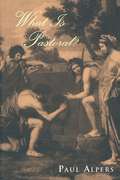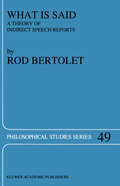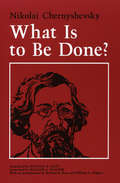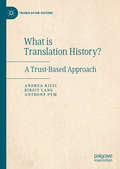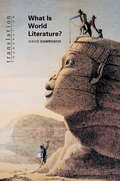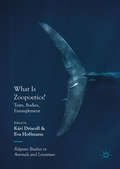- Table View
- List View
What is Morphology? (Fundamentals of Linguistics #9)
by Mark Aronoff Kirsten FudemanProvides a critical introduction to the central ideas and perennial problems of morphology, fully revised and updated in a new edition What is Morphology? is a concise, student-friendly introduction to the fundamentals of contemporary morphological theory and practice. Requiring only a basic knowledge of linguistics, this popular textbook describes morphological phenomena and their interactions with phonology, syntax, and semantics while familiarizing students with the importance of linguistic morphology as a subject of research. Each chapter contains engaging examples and student-friendly explanations to support the development of the skills necessary to analyze a wealth of classic morphological problems. The third edition is fully updated to reflect the current state of the field, featuring a new chapter on morphology&’s intersections with typology and computational linguistics. Expanded coverage of morphological productivity and processing is supported by additional exercises, examples, and further reading suggestions. Thoroughly revised chapters cover essential topics including morphemes, the lexicon, phonology, inflection, syncretism, and derived lexemes. This accessible textbook: Introduces fundamental phenomena with a descriptive theme and minimal theory Uses cross-linguistic data to explain and clarify new concepts Provides new and revised chapters written by prominent experts in their respective areas Includes answers to all exercises via a companion instructor&’s websiteThe latest edition of What is Morphology? remains the ideal textbook for undergraduate and graduate linguistics students, researchers and scholars unfamiliar with linguistic morphology, and professionals involved in industrial applications of linguistics such as speech recognition, natural language understanding, machine translation, text-to-speech, and natural language generation.
What is Morphology? (Fundamentals of Linguistics)
by Mark Aronoff Kirsten FudemanProvides a critical introduction to the central ideas and perennial problems of morphology, fully revised and updated in a new edition What is Morphology? is a concise, student-friendly introduction to the fundamentals of contemporary morphological theory and practice. Requiring only a basic knowledge of linguistics, this popular textbook describes morphological phenomena and their interactions with phonology, syntax, and semantics while familiarizing students with the importance of linguistic morphology as a subject of research. Each chapter contains engaging examples and student-friendly explanations to support the development of the skills necessary to analyze a wealth of classic morphological problems. The third edition is fully updated to reflect the current state of the field, featuring a new chapter on morphology&’s intersections with typology and computational linguistics. Expanded coverage of morphological productivity and processing is supported by additional exercises, examples, and further reading suggestions. Thoroughly revised chapters cover essential topics including morphemes, the lexicon, phonology, inflection, syncretism, and derived lexemes. This accessible textbook: Introduces fundamental phenomena with a descriptive theme and minimal theory Uses cross-linguistic data to explain and clarify new concepts Provides new and revised chapters written by prominent experts in their respective areas Includes answers to all exercises via a companion instructor&’s websiteThe latest edition of What is Morphology? remains the ideal textbook for undergraduate and graduate linguistics students, researchers and scholars unfamiliar with linguistic morphology, and professionals involved in industrial applications of linguistics such as speech recognition, natural language understanding, machine translation, text-to-speech, and natural language generation.
What Is Pastoral?
by Paul AlpersOne of the enduring traditions of Western literary history, pastoral is often mischaracterized as a catchall for literature about rural themes and nature in general. In What Is Pastoral?, distinguished literary historian Paul Alpers argues that pastoral is based upon a fundamental fiction—that the lives of shepherds or other socially humble figures represent the lives of human beings in general. Ranging from Virgil's Eclogues to Sarah Orne Jewett's The Country of the Pointed Firs, from Shakespeare and Cervantes to Hardy and Frost, this work brings the story of the pastoral tradition, previously limited to classical and Renaissance literature, into the twentieth century. Pastoral reemerges in this account not as a vehicle of nostalgia for some Golden Age, nor of escape to idyllic landscapes, but as a mode bearing witness to the possibilities and problems of human community and shared experience in the real world. A rich and engrossing book, What Is Pastoral? will soon take its place as the definitive study of pastoral literature. "Alpers succeeds brilliantly. . . . [He] offers . . . a wealth of new insight into the origins, development, and flowering of the pastoral."—Ann-Maria Contarino, Renaissance Quarterly
What is Québécois Literature?: Reflections on the Literary History of Francophone Writing in Canada (Contemporary French and Francophone Cultures #28)
by Rosemary ChapmanAn Open Access edition of this book is available on the Liverpool University Press website and the OAPEN library.The question ‘What is Québécois literature?’ may seem innocent and answerable, yet Rosemary Chapman's compelling study shows that to answer it is to chart the cultural history of French Canada, to put francophone writing in Canada in postcolonial context and to ask whether literary history, with its focus on the nation, is in fact obsolete. This remarkable book will be compulsory reading for scholars well-versed in francophone postcolonial studies and will also act as an ideal introduction for Anglophone scholars of Canadian literature.
What is Rhetoric?
by Michel MeyerThis book offers a new approach to the principles and functioning of rhetoric. In everyday life, we often debate issues or simply discuss questions. Rhetoric is the way in which we answer questions in an interpersonal context, when we want to have an effect on those with whom we are communicating. They can be convinced or charmed, persuaded or influenced, and the language used can range from reasoning to the sharing of narratives, literary or otherwise. What is Rhetoric? provides a breakthrough in the field, offering a systematic and unified view of the topic. The book combines the social aspects of rhetoric, such as the negotiation of distance between speakers, with the theory of emotions. All the principal authors from Plato and Aristotle to contemporary theorists are integrated into Michel Meyer's "problematological" conception of rhetoric, based on the primacy of questioning and answering in language and thought.
What is Rhetoric?
by Michel MeyerThis book offers a new approach to the principles and functioning of rhetoric. In everyday life, we often debate issues or simply discuss questions. Rhetoric is the way in which we answer questions in an interpersonal context, when we want to have an effect on those with whom we are communicating. They can be convinced or charmed, persuaded or influenced, and the language used can range from reasoning to the sharing of narratives, literary or otherwise. What is Rhetoric? provides a breakthrough in the field, offering a systematic and unified view of the topic. The book combines the social aspects of rhetoric, such as the negotiation of distance between speakers, with the theory of emotions. All the principal authors from Plato and Aristotle to contemporary theorists are integrated into Michel Meyer's "problematological" conception of rhetoric, based on the primacy of questioning and answering in language and thought.
What is Said: A Theory of Indirect Speech Reports (Philosophical Studies Series #49)
by R. BertoletThe notion of what someone says is, perhaps surprisingly, some what less clear than we might be entitled to expect. Suppose that I utter to my class the sentence 'I want you to write a paper reconciling the things Russell claims about propositions in The Philosophy of Mathematics for next week'. A student who was unable to get up in time for class that day asks another what I said about the assignment. Several replies are in the offing. One, an oratio recta or direct speech report, is 'He said, "I want you to write a paper reconciling the things Russell claims about propositions in The Philosophy of Mathematics for next week. '" Another, an oratio obliqua or indirect speech report, consists in the response 'He said that he wants us to write a paper reconciling . . . '. Yet another, reflecting a perhaps accurate estimate of the task involved, editorializes: 'He said he wants us to do the impossible'. Or, aware of both this and my quaint custom of barring those who have not successfully completed the assignment from the classroom, one might retort 'He said he doesn't want to meet next week'. Since 'says' is construable in these various ways, it is at best unhelpful to write something like 'Alice said "Your paper is two days late", thereby saying that Tom's paper was two days late.
What Is Sociolinguistics? (Linguistics in the World #10)
by Gerard Van HerkHow is our language affected by our ethnicity, gender, and region? How are our conversations and other interactions structured? How does society view and regulate language? How do we use language to present ourselves to others? In this revised and updated second edition of the popular What Is Sociolinguistics? Gerard Van Herk explores these and other intriguing questions about language, how we use it, and its relationships to society. Van Herk guides the reader on a tour through the major issues that define the field, including region, status, gender, time, language attitudes, interaction, and style, at the same time exploring the sociolinguistics of multilingualism, culture and ethnicity, language contact, and education. This second edition has been revised and updated to include new and more exercises, discussion questions, and suggested readings, as well as expanded chapters exploring gender duality and Latino English. Key readings are introduced in Van Herk’s clear and engaging voice, which accompanies the text throughout, providing an accessible point of entry for those new to, or less familiar with, sociolinguistics. Chapter summaries and textboxes are similarly employed to signpost and illuminate learning. A companion website features PowerPoint slides for each chapter with suggestions for framing class discussions and exercises, further examples of concepts discussed, additional reading suggestions, and ready-to-go slides for class presentation. Packed with the latest research and practical teaching aids, What is Sociolinguistics? Second edition retains the highly-praised character of its predecessor and provides an essential up-to-date text for both students and instructors alike.
What Is Sociolinguistics? (Linguistics in the World)
by Gerard Van HerkHow is our language affected by our ethnicity, gender, and region? How are our conversations and other interactions structured? How does society view and regulate language? How do we use language to present ourselves to others? In this revised and updated second edition of the popular What Is Sociolinguistics? Gerard Van Herk explores these and other intriguing questions about language, how we use it, and its relationships to society. Van Herk guides the reader on a tour through the major issues that define the field, including region, status, gender, time, language attitudes, interaction, and style, at the same time exploring the sociolinguistics of multilingualism, culture and ethnicity, language contact, and education. This second edition has been revised and updated to include new and more exercises, discussion questions, and suggested readings, as well as expanded chapters exploring gender duality and Latino English. Key readings are introduced in Van Herk’s clear and engaging voice, which accompanies the text throughout, providing an accessible point of entry for those new to, or less familiar with, sociolinguistics. Chapter summaries and textboxes are similarly employed to signpost and illuminate learning. A companion website features PowerPoint slides for each chapter with suggestions for framing class discussions and exercises, further examples of concepts discussed, additional reading suggestions, and ready-to-go slides for class presentation. Packed with the latest research and practical teaching aids, What is Sociolinguistics? Second edition retains the highly-praised character of its predecessor and provides an essential up-to-date text for both students and instructors alike.
What Is Sociolinguistics? (Linguistics in the World #10)
by Gerard Van HerkWhat is Sociolinguistics? is a tour through the major issues that define the field, such as region, status, gender, time, language attitudes, interaction, and style, while also exploring the sociolinguistics of multilingualism, culture and ethnicity, language contact, and education, all introduced with excitement, humor, and deep knowledge. Explores the sociolinguistics of multilingualism, culture and ethnicity, language contact, and education Provides useful and clear learning features including numerous innovative exercises and project ideas, spotlighted research readings, glossary terms, chapter summaries, and text boxes The Companion Website for Instructors (www.wiley.com/go/vanherkprofs) has PowerPoint slides for each chapter with suggestions for framing class discussions and exercises, further examples on concepts discussed in the book, tips on additional readings to bring in, and ready-to-go slides for class presentation. The Companion Website for Students (www.wiley.com/go/vanherk) includes links for every chapter from standard sociolinguistic tools to links designed to spark discussion relevant to each chapter, including video clips, oral histories, articles, and more.
What Is Sociolinguistics? (Linguistics in the World #9)
by Gerard Van HerkWhat is Sociolinguistics? is a tour through the major issues that define the field, such as region, status, gender, time, language attitudes, interaction, and style, while also exploring the sociolinguistics of multilingualism, culture and ethnicity, language contact, and education, all introduced with excitement, humor, and deep knowledge. Explores the sociolinguistics of multilingualism, culture and ethnicity, language contact, and education Provides useful and clear learning features including numerous innovative exercises and project ideas, spotlighted research readings, glossary terms, chapter summaries, and text boxes The Companion Website for Instructors (www.wiley.com/go/vanherkprofs) has PowerPoint slides for each chapter with suggestions for framing class discussions and exercises, further examples on concepts discussed in the book, tips on additional readings to bring in, and ready-to-go slides for class presentation. The Companion Website for Students (www.wiley.com/go/vanherk) includes links for every chapter from standard sociolinguistic tools to links designed to spark discussion relevant to each chapter, including video clips, oral histories, articles, and more.
What is the Grass: Walt Whitman In My Life
by Mark DotyMark Doty has always felt haunted by Walt Whitman’s bold, new American voice, and by his equally radical claims about body and soul and what it means to be a self. In What Is the Grass, Doty – a poet, a lover of men, a New Yorker, and an American – keeps company with Whitman and his mutable, landmark work, Leaves of Grass, tracing the resonances between his own experience and the legendary poet’s life and work.What is it, then, between us? Whitman asks. Doty’s answer is to explore spaces tied to Whitman’s life and spaces where he finds the poet’s ghost, meditating on desire, love, and the mysterious wellsprings of the poet’s enduring work. How does a voice survive death? What Is the Grass is a conversation across time and space, a study of the astonishment one poet finds in the accomplishment of another, and an attempt to grasp Whitman’s deeply hopeful vision of humanity.
What is the History of Knowledge? (What is History?)
by Peter BurkeWhat is the history of knowledge? This engaging and accessible introduction explains what is distinctive about the new field of the history of knowledge (or, as some scholars say, ‘knowledges in the plural’) and how it differs from the history of science, intellectual history, the sociology of knowledge or from cultural history. Leading cultural historian, Peter Burke, draws upon examples of this new kind of history from different periods and from the history of India, East Asia and the Islamic world as well as from Europe and the Americas. He discusses some of the main concepts used by scholars working in the field, among them ‘order of knowledge’, ‘situated knowledge’ and ‘knowledge society’. This book tells the story of the transformation of relatively raw ‘information’ into knowledge via processes of classification, verification and so on, the dissemination of this knowledge and finally its employment for different purposes, by governments, corporations or private individuals. A concluding chapter identifies central problems in the history of knowledge, from triumphalism to relativism, together with attempts to solve them. The only book of its kind yet to be published, What is the History of Knowledge? will be essential reading for all students of history and the humanities in general, as well as the interested general reader.
What is the History of the Book? (What is History?)
by James RavenJames Raven, a leading historian of the book, offers a fresh and accessible guide to the global study of the production, dissemination and reception of written and printed texts across all societies and in all ages. Students, teachers, researchers and general readers will benefit from the book's investigation of the subject's origins, scope and future direction. Based on original research and a wide range of sources, What is the History of the Book? shows how book history crosses disciplinary boundaries and intersects with literary, historical, media, library, conservation and communications studies. Raven uses examples from around the world to explore different traditions in bibliography, palaeography and manuscript studies. He analyses book history's growing global ambition and demonstrates how the study of reading practices opens up new horizons in social history and the history of knowledge. He shows how book history is contributing to debates about intellectual and popular culture, colonialism and the communication of ideas. The first global, accessible introduction to the field of book history from ancient to modern times, What is the History of the Book? is essential reading for all those interested in one of society's most important cultural artefacts.
What Is the Present?: A History of the Here and Now
by Michael NorthA provocative new look at concepts of the present, their connection to ideas about time, and their effect on literature, art, and cultureThe problem of the present—what it is and what it means—is one that has vexed generations of thinkers and artists. Because modernity places so much value on the present, many critics argue that people today spend far too much time in the here and now—but how can we tell without first knowing what the here and now actually is? What Is the Present? takes a provocative new look at this moment in time that remains a mystery even though it is always with us.Michael North tackles puzzles that have preoccupied philosophy, neuroscience, psychology, history, and aesthetic theory and examines the complex role of the present in painting, fiction, and film. He engages with a range of thinkers, from Aristotle and Augustine to William James and Henri Bergson. He draws illuminating examples from artists such as Fra Angelico and Richard McGuire, filmmakers like D. W. Griffith and Christopher Nolan, and novelists such as Elizabeth Bowen and Willa Cather. North offers a critical analysis of previous models of the present, from the experiential present to the historical period we call the contemporary. He argues that the present is not a cosmological or experiential fact but a metaphor, a figurative relationship with the whole of time. Presenting an entirely new conception of the temporal mystery Georg Lukács called the "unexplained instant," What Is the Present? explores how the arts have traditionally represented the present—and also how artists have offered radical alternatives to that tradition.
What Is the Present?: A History of the Here and Now
by Michael NorthA provocative new look at concepts of the present, their connection to ideas about time, and their effect on literature, art, and cultureThe problem of the present—what it is and what it means—is one that has vexed generations of thinkers and artists. Because modernity places so much value on the present, many critics argue that people today spend far too much time in the here and now—but how can we tell without first knowing what the here and now actually is? What Is the Present? takes a provocative new look at this moment in time that remains a mystery even though it is always with us.Michael North tackles puzzles that have preoccupied philosophy, neuroscience, psychology, history, and aesthetic theory and examines the complex role of the present in painting, fiction, and film. He engages with a range of thinkers, from Aristotle and Augustine to William James and Henri Bergson. He draws illuminating examples from artists such as Fra Angelico and Richard McGuire, filmmakers like D. W. Griffith and Christopher Nolan, and novelists such as Elizabeth Bowen and Willa Cather. North offers a critical analysis of previous models of the present, from the experiential present to the historical period we call the contemporary. He argues that the present is not a cosmological or experiential fact but a metaphor, a figurative relationship with the whole of time. Presenting an entirely new conception of the temporal mystery Georg Lukács called the "unexplained instant," What Is the Present? explores how the arts have traditionally represented the present—and also how artists have offered radical alternatives to that tradition.
What is This Thing Called Language?
by David NunanThis book is a lively introduction to the study of language by the renowned linguist, David Nunan. Drawing on a wide range of anecdotes, Nunan offers a thought-provoking way in to the basics of language study. The book is framed by accessible features including questions, further reading and a glossary of linguistic terminology and key linguists.
What Is This Thing Called Language?
by David NunanWritten by eminent linguist David Nunan, this concise text immerses readers in the complex, curious and continually evolving phenomenon that is at the centre of everything we do: language. It can be fascinating, puzzling and entertaining – and sometimes all of these at the same time. Featuring entertaining anecdotes and interesting examples throughout, this book introduces readers to the foundations of language, namely its sounds, words and grammar, before illustrating how language is used in different ways in a variety of contexts. Fully updated and revised for the second edition, it covers a wide range of topics, including language variation and culture, second language acquisition and bilingualism. Students, teachers and non-specialists alike will enjoy this engaging and ‘un-put-down-able’ introduction to language and linguistics. Assuming no prior knowledge of applied or theoretical linguistics, it will appeal to anyone with an interest in language.
What Is This Thing Called Language?
by David NunanWritten by eminent linguist David Nunan, this concise text immerses readers in the complex, curious and continually evolving phenomenon that is at the centre of everything we do: language. It can be fascinating, puzzling and entertaining – and sometimes all of these at the same time. Featuring entertaining anecdotes and interesting examples throughout, this book introduces readers to the foundations of language, namely its sounds, words and grammar, before illustrating how language is used in different ways in a variety of contexts. Fully updated and revised for the second edition, it covers a wide range of topics, including language variation and culture, second language acquisition and bilingualism.Students, teachers and non-specialists alike will enjoy this engaging and 'un-put-down-able' introduction to language and linguistics. Assuming no prior knowledge of applied or theoretical linguistics, it will appeal to anyone with an interest in language. New to this Edition:- Illustrated with examples taken from a range of different languages- New content on language and culture, language variation, second language acquisition, bilingualism and the impact of globalization on language use
What is this thing called Language? (PDF)
by David NunanWritten by eminent linguist David Nunan, this concise text immerses readers in the complex, curious and continually evolving phenomenon that is at the centre of everything we do: language. It can be fascinating, puzzling and entertaining – and sometimes all of these at the same time.
What Is to Be Done?
by Nikolai ChernyshevskyAlmost from the moment of its publication in 1863, Nikolai Chernyshevsky's novel, What Is to Be Done?, had a profound impact on the course of Russian literature and politics. The idealized image it offered of dedicated and self-sacrificing intellectuals transforming society by means of scientific knowledge served as a model of inspiration for Russia's revolutionary intelligentsia. On the one hand, the novel's condemnation of moderate reform helped to bring about the irrevocable break between radical intellectuals and liberal reformers; on the other, Chernyshevsky's socialist vision polarized conservatives' opposition to institutional reform. Lenin himself called Chernyshevsky "the greatest and most talented representative of socialism before Marx"; and the controversy surrounding What Is to Be Done? exacerbated the conflicts that eventually led to the Russian Revolution.Michael R. Katz's readable and compelling translation is now the definitive unabridged English-language version, brilliantly capturing the extraordinary qualities of the original. William G. Wagner has provided full annotations to Chernyshevsky's allusions and references and to the, sources of his ideas, and has appended a critical bibliography. An introduction by Katz and Wagner places the novel in the context of nineteenth-century Russian social, political, and intellectual history and literature, and explores its importance for several generations of Russian radicals.
What is Translation History?: A Trust-Based Approach (Translation History)
by Andrea Rizzi Birgit Lang Anthony PymThis book presents a dynamic history of the ways in which translators are trusted and distrusted. Working from this premise, the authors develop an approach to translation that speaks to historians of literature, language, culture, society, science, translation and interpreting. By examining theories of trust from sociological, philosophical, and historical studies, and with reference to interdisciplinarity, the authors outline a methodology for approaching translation history and intercultural mediation from three discrete, concurrent perspectives on trust and translation: the interpersonal, the institutional and the regime-enacted. This book will be of particular interest to students and scholars of translation studies, as well as historians working on mediation and cultural transfer.
What Is World Literature? (Translation/Transnation (PDF))
by David DamroschWorld literature was long defined in North America as an established canon of European masterpieces, but an emerging global perspective has challenged both this European focus and the very category of "the masterpiece." The first book to look broadly at the contemporary scope and purposes of world literature, What Is World Literature? probes the uses and abuses of world literature in a rapidly changing world. In case studies ranging from the Sumerians to the Aztecs and from medieval mysticism to postmodern metafiction, David Damrosch looks at the ways works change as they move from national to global contexts. Presenting world literature not as a canon of texts but as a mode of circulation and of reading, Damrosch argues that world literature is work that gains in translation. When it is effectively presented, a work of world literature moves into an elliptical space created between the source and receiving cultures, shaped by both but circumscribed by neither alone. Established classics and new discoveries alike participate in this mode of circulation, but they can be seriously mishandled in the process. From the rediscovered Epic of Gilgamesh in the nineteenth century to Rigoberta Menchú's writing today, foreign works have often been distorted by the immediate needs of their own editors and translators. Eloquently written, argued largely by example, and replete with insightful close readings, this book is both an essay in definition and a series of cautionary tales.
What Is World Literature? (PDF)
by David DamroschWorld literature was long defined in North America as an established canon of European masterpieces, but an emerging global perspective has challenged both this European focus and the very category of "the masterpiece." The first book to look broadly at the contemporary scope and purposes of world literature, What Is World Literature? probes the uses and abuses of world literature in a rapidly changing world. In case studies ranging from the Sumerians to the Aztecs and from medieval mysticism to postmodern metafiction, David Damrosch looks at the ways works change as they move from national to global contexts. Presenting world literature not as a canon of texts but as a mode of circulation and of reading, Damrosch argues that world literature is work that gains in translation. When it is effectively presented, a work of world literature moves into an elliptical space created between the source and receiving cultures, shaped by both but circumscribed by neither alone. Established classics and new discoveries alike participate in this mode of circulation, but they can be seriously mishandled in the process. From the rediscovered Epic of Gilgamesh in the nineteenth century to Rigoberta Menchú's writing today, foreign works have often been distorted by the immediate needs of their own editors and translators. Eloquently written, argued largely by example, and replete with insightful close readings, this book is both an essay in definition and a series of cautionary tales.
What Is Zoopoetics?: Texts, Bodies, Entanglement (Palgrave Studies in Animals and Literature)
by Kári Driscoll Eva HoffmannThis book brings together essays dealing with the question of zoopoetics both as an object of study—i.e. texts from various traditions and periods that reflect, explicitly or implicitly, on the relationship between animality, language and representation—and as a methodological problem for animal studies, and, indeed, for literary studies more generally. What can literary animal studies tell us about literature that conventional literary studies might be blind to? How can literary studies resist the tendency to press animals into symbolic service as metaphors and allegories for the human whilst also avoiding a naïve literalism with respect to the literary animal? The volume is divided into three sections: “Texts,” which focuses on the linguistic and metaphorical dimensions of zoopoetics; “Bodies,” which is primarily concerned with mimesis and questions of embodiment, performance, and lived experience; and “Entanglement,” which focuses on interspecies encounters and the complex interplay between word and world that emerges from them. The volume will appeal to scholars and students in the fields of animal studies, area studies and comparative literature, gender studies, environmental humanities, ecocriticism, and the broader field of posthumanism.

